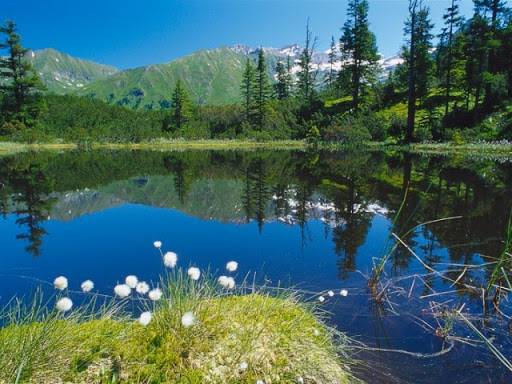Danube River
The Danube floodplain meadows located between Vienna and Bratislava were saved at the last moment from the threat of hydroelectric power station construction. It can be said to be one of the few remaining floodplain landscapes in Central Europe. Now the river can continue to exhibit its landscape features and sustain a large number of plants and wildlife: over 60 species of fish, kingfishers, eagles, beavers, turtles, rare orchids, and countless insects thrive here. This 'green wilderness in the stream,' which is 38 kilometers long and 4 kilometers wide, offers a delightful natural environment.
Gesäuse National Park
Gesäuse National Park is the third largest and newest national park in Austria, with an elevation ranging from the lowest point at 490 meters to the peak of Hochtor at 2370 meters. It is a natural habitat for chickens, marmots, chamois, deer, and roe deer, with up to 90 species. You can also see 50 different species of wild orchids. The nearby Admont Benedictine Monastery, with its long history, is worth a visit.
Hohe Tauern National Park
Hohe Tauern National Park spans the Austrian states of Tyrol, Carinthia, and Salzburg, making it the largest national park in Central Europe. It is home to a variety of natural wonders, such as Austria's highest peak, Grossglockner, massive glaciers, and the spectacular Krimml Waterfalls. The hiking network and the system of via ferrata in the Alps extend approximately 1200 kilometers. More than 80 mountain huts provide perfect infrastructure for long-distance hikes and short trips to the southern end of the Tauern range, where 240 peaks over 3000 meters stand tall.
Kalkalpen National Park
Kalkalpen National Park is Austria's largest continuous forest base. Pine, birch, and beech trees cover four-fifths of the land, where trees grow, mature, and die according to natural laws. You can also enjoy spectacular gorges, picturesque waterfalls, and lakes. The Ennstal Visitor Center will tell you everything about the national park and is an ideal starting point for short trips into Kalkalpen National Park. The Kalkalpen National Park area is a mature cultural landscape. As a habitat for flora and fauna, it not only protects the environment but also serves as a basis for human survival and recreational space, making it significant. Most importantly, the pristine environment provides the foundation for the quality of leisure and tourism areas. Kalkalpen National Park is part of the network of natural heritage conservation areas.
Neusiedler See National Park
The reed belt surrounding Neusiedler See National Park is the second largest in Europe, only after the Danube Delta. A variety of flora and fauna native to the Alpine region, Pannonia, Asia, the Mediterranean, and Northern Europe coexist in the saline lake and vast grasslands, creating a unique biodiversity: here, the croaking of Balkan frogs can be heard, the tarantulas from southern Russia hunt for prey, the great bustards breed peacefully, Austrian wormwood and Hungarian yellow vetch are common sights, and gray steppe cattle, white wild donkeys, and wild horses gallop across the grasslands of the lakeside nature reserve. As a bird migration site between Europe and Africa, Neusiedler See is of great importance, known as a bird paradise in Europe, a haven for ornithologists, and a paradise for cycling and horse riding enthusiasts.
Thayatal National Park
Nearly half of Austria's native plants grow in this relatively small area. Due to decades under the Iron Curtain, the valley located on the border with the Czech Republic has remained almost untouched and undeveloped. Because of its geographical location and inconvenient transportation, Thayatal National Park and the valley's 90% forest-covered land have not been damaged by logging companies. What was once unimaginable is now so simple: part of the national park is located in the Czech Republic, allowing for cross-border hiking or cycling exploration.















